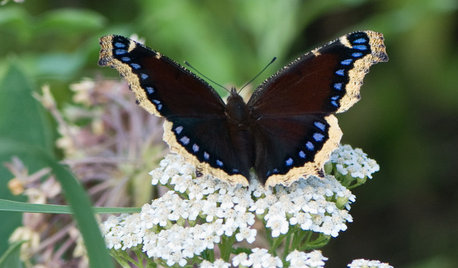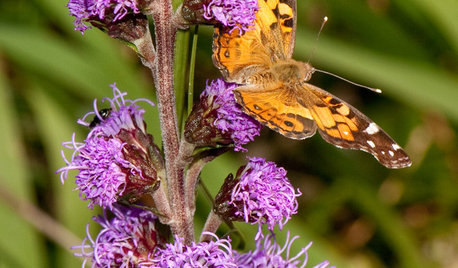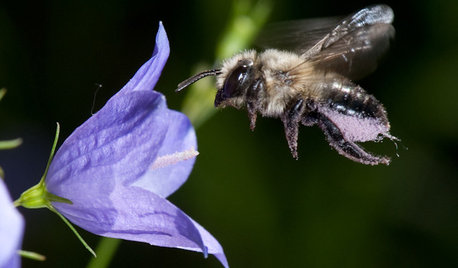A guide to identifying potential [and bad] butterfly plants at a glance
Got done early today, and was bored so I thought I would write a flower structure guide for newbies. Those of you who have been butterfly gardening for awhile likely already know this stuff. In that case you can just skip over this.
__________________________________________________
.
.
- Intro
When I started butterfly gardening, I only knew that there were butterfly flowers, and then there werent. I knew this because, well, some people said "this is a good butterfly flower" and "this is not a good butterfly flower". Alright. But why? And how can you tell? ThatÂs why I made this guide, because I would have wanted to know this information a long time ago.
- Why donÂt butterflies like certain flowers?
The short answer is: many flowers have nothing to offer them. To understand this, we need to understand the pollinator.
A butterfly is just one pollinator. In your garden it is but one of many, and all of these pollinators have different needs. Some other common pollinators are bees, birds, and flies. Sometimes a flower has no pollinators, but uses the wind instead. There are many more unusual (slugs and beetles for example) ones but we are not concerned with that. Keep in mind most butterflies drink nectar (with rare exceptions). If they cannot reach the nectar or the flower does not have nectar, they will not visit.
- The pollinators
Bees
The most common and important pollinators in the world are Bees . Bees need two things: nectar and pollen. They also usually need a landing platform. Bees are the only insects that can perform certain forms of pollination (buzz) and cannot usually see red.
Many if not most flowers we come across are bee pollinated, and they may offer only pollen, only nectar, or both. Plants with abundant pollen are usually bee pollinated, and as they donÂt offer any nectar for butterflies, they are of no use to butterflies (besides some that can eat pollen, but most cannot)
Here are some common examples of bee-pollinated flowers:
{{gwi:192664}}
A rose has abundant pollen-bearing stamens for bees but little nectar. The petals provide a good landing platform. This is NOT a good butterfly plant because it offers little nectar. As a general rule, flowers that offer abundant amounts of pollen usually have that, and not nectar, as their "reward"
Another example of a common plant that provide pollen but not nectar is spirea.
This flower
{{gwi:451018}}
Has a landing platform and provides nectar. The bees must crawl in to access this, and so some butterflies may be excluded. flowers that force a insect to crawl into them are usually bee pollinated, but butterflies may be excluded because they may not be able to reach nectar. Sometimes a butterfly can slip its probosicis in there to get a sip, but they often do not bother.
Birds
Birds like flowers they can hover in front of, so these often have no landing platform for bees or butterflies. Birds like tubular flowers in red or orange. Below is an example of a hummingbird pollinated flower. Note there is nowhere for bugs to land. {{gwi:451021}}
Flies
Flies may feed on nectar or pollen. Most flies that covet nectar have short mouthparts (always with exceptions). So the flowers are usually small and compact, with nectar very close to the surface for easy access. These flowers also appeal to wasps and bees with short tongues.
{{gwi:451024}}
These flowers may be too small to be of interest, though small butterflies might visit
Another type of fly feeds on pollen, but they visit any flower that has pollen and are usually non-pollinating.
- But i see many different bugs on my flowers!
Bugs are flexible! They donÂt limit themselves to whatever is made just for them. Many flowers take MANY DIFFERENT POLLINATORS. They are not restricted to one or the other sometimes, many plants do double duty. Often, [nectar & nectar + pollen] bee and butterfly plants do double duty. Remember that
-So what flowers do butterflies like already!!!!
Im getting to that! Butterflies have long narrow proboscises, so a plant with long narrow tubes are often perfect for them- but the tubes need not be long, sometimes they are short. In that case bees may visit too. But butterflies also need a place to land! If there is no place to land butterflies cant get access to the flowers. Flowers need to be able to support their weight
Some flowers with tubes and landing areas are
{{gwi:451027}}
And
{{gwi:451029}}
Do you see the landing platforms and the long tubes? Those are usually sure-fire signs of a first-rate butterfly plant.
- Not restricted to just certain types of flowers
Butterflies also will visit bee flowers! Some salvias with short spurs, landing platforms with deep, tubular flowers such as chives and the pink beebalms. They are not restricted to just a certain type of flower, they can be found on whatever they can get often. Sometimes there are no textbook "butterfly" flowers in an area. You will find them on things such as clover, alfalfa and asters. These are "bee" flowers but not just bees use them. But bee flowers that just offer pollen are useless to most butterflies.
_________________________________________________
So by knowing what makes a plant that is not attractive to butterflies, and knowing what makes a plant acceptable to butterflies, you might not even need to know what the name of the plant in question is to assess whether or not this plant is useful to butterflies. This is helpful for those areas where butterflies are not common enough to be able to tell you themselves what they like. And they will surprise you, they may shun "perfect" flowers in favor of something they are not "supposed" to like. If in doubt, just watch the animals and they will tell you but you might not need them there to get a general idea.
* yes I know there are a bunch of errors in here somewhere (there always are), but im too burned out to proofread. If you have anything to add or if i am wrong on something dont hesitate to say it.

















tdogmom
butterfly_pixie
Related Professionals
Elwood Landscape Architects & Landscape Designers · Mason Landscape Contractors · Mission Bend Landscape Contractors · North Haven Landscape Contractors · Stallings Landscape Contractors · Suisun City Landscape Contractors · Baltimore Fence Contractors · Bellevue Fence Contractors · Parker Fence Contractors · Simi Valley Fence Contractors · Sun City Fence Contractors · Bridgeport Window Contractors · Coral Terrace Window Contractors · Decatur Window Contractors · Framingham Window ContractorsMissSherry
Fledgeling_Original Author